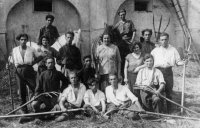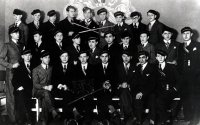Hachshara camps in Austria
Janina Böck-Koroschitz's dissertation project explores the history of the Austrian hachshara's origins, its course, the organisations and persons involved, as well as its history of impact.
The Hebrew word hachshara means preparation (literally: making fit) for an agricultural and craft activity in Palestine/Erez Israel. In the 1920s, Jewish youth organisations began to set up camps in eastern Austria to offer young people the opportunity to emigrate to Palestine/Erez Israel. Under the British Mandate government, the immigration regulations were very strict and clearly formulated, as the new immigrants were supposed to be of use to the state and be able to help build up the country.
For this purpose, the various youth organisations under the auspices of Hechaluz (Hebrew for pioneer) set up Hachshara camps, where young people between 15 and 18 years of age learned agricultural and craft activities. In addition to practical lessons, there were also theoretical lessons. These included Hebrew, Jewish and Zionist history, Palestine studies, natural sciences, geography and first aid. The participating youths were called Chawerim/Chawerot (Hebrew comrades, friends) or Chaluzim/Chaluzot (Hebrew pioneers). The camps were mainly set up on estates, castles or farms, which mostly belonged to Jewish owners. A stay in the camps was planned for about 2 years and ended with an examination. The best participants could expect to emigrate to Palestine/Erez Israel.
When the National Socialists came to power in Austria in 1938, the function of the Hachshara camps changed abruptly. While the beginnings of the Hachshara were primarily ideological until 1938, from then on its position changed to a purely refugee organisation. For many young people, participation in the Hachshara was the last hope of escape from Austria. The age requirements were relaxed so that younger and older people also had a chance at Hachshara. The length of stay in a camp was also reduced from two years to sometimes weeks or only a few days.
Information:|mail: Mag. Janina Böck-Koroschitz|
This project is funded within the framework of the research project |NS-"Volksgemeinschaft" und Lager im Zentralraum Niederösterreich. History - Contact Zones - Memory|, funded by the Lower Austrian Government, Department of Science and Research.

„Kosher” lederhosen, „jewish” dirndl?
The wearing of „Tracht“ as a representation of affiliation in Vienna and Lower Austria between the burgeoning summer retreats in the 19th century and 1938
Between the second half of the 19th century and 1938, photographs can show prominent Jewish members of the upper class and artists in „Tracht“ (=traditional costumes) – often in the relaxed atmosphere of their summer retreat. Theodor Herzl and his family stayed in Altaussee, Sigmund Freud and his daughter Anna climbed the Dolomites and Arthur Schnitzler resided at the Semmering. All of them have been pictured in Tracht or costum-like clothing.
The dissertation project by Merle Bieber takes these image sources as an opportunity to research the use, possession and symbolic character of „Tracht” and costume-like clothing.
In the 19th century, the „alpine" costume/„Tracht“ was cultivated by the aristocratic milieu in the Salzkammergut and modified for leisure wear during the burgeoning summer retreats. The „Tracht“ lighted the romantic desire for a lost „idyllic world” and was an expression of the need for affiliation for the Jewish population.This affiliation is among other things visible through photographs showing Jews in „Tracht“, but is also evident in the rejection of this appropriation. The Jewish need for acceptance was finally brought to an end by the Nazis’ ban on traditional costumes („Trachtenverbot“) for Jews on June 20th, 1938.
The work is limited to sources that are directly related to Vienna and Lower Austria. The time frame extends from the burgeoning summer retreats during the 19th century to the implementation of the ban on traditional costumes („Trachtenverbot“) for Jews in June 1938. Although most of the the sources date from 1880 to 1938, some of them can draw a bow in a case study to the topics of emigration and exile as well as the importance for descendants up to the present day.
The topic is located in the field of tension between the concepts of acculturation and identity. Clothing has always been used as a characteristic of identity. Affiliation is symbolized by clothing, at the same time the rejection of this affiliation is made visible by a ban on the clothing.
Doctoral candidate: |mail: Merle Bieber|
Supervision: |mail: Martha Keil|
We would like to express our thanks to Land Niederösterreich for the support of this project.

Jewish Student Corporations in the Austro-Hungarian Monarchy and its Successor States 1882-1938
Dissertation by Arik Shoihtman
Institute for History/University of Vienna
Supervision: PD Dr. Martha Keil
Studentenverbindungen are a specific form of a student fraternity ⎯ otherwise known as corporations ⎯ found in German-speaking countries. After the 1867 constitution and civil rights act, Jews started to attend universities throughout the Habsburgian realm without the need to convert their religion. Parallel to academic studies, many Jews were accepted into various student corporations (Studentenverbindungen).
Taking part in a student corporation was very common at that time and besides being a way of socializing, participation offered opportunities for networking. Furthermore, the awakening of patriotism made many declare themeselves as Germans or Austrians of Mosaic religion willing to fully integrate into society. As a response to the growing anti-Semitic climate that prevailed in the Burschenschaften in the 1880s, Jewish students started to establish their own student corporations. With the foundation of Kadimah in Vienna in 1882, followed by the establishment of several similar corporations throughout the Austro-Hungarian monarchy, a whole spectrum of Jewish student corporations started to take shape with similar corporations emerging all over the Habsburgian empire. They typically adopted the style, traditions, social codices and paraphernalia of their Austrian counterparts, many of which were adapted to fit Jewish heritage or invented anew. Embracing the concepts of bearing arms, honour and other traits of the Verbindung which articulated the essence of their existence, the Jewish student corporations played a decisive role in modern Jewish history and helped to forge the Jewish modernity.
The dissertation will deal with the following research questions:
- What was the background and what were the reasons that led to the establishment of Jewish student corporations (including internal and external)?
- What kind of Jewish student corporations existed?
- What were the general political and Jewish national ideas that prevailed in the Jewish student corporations and what was their contribution to Zionist ideology?
- What were the social traits of the Jewish student corporations? (Duelling, brotherhood, male-association, life-long bond) and how did those traits infuse their new Jewish identity and herald the arrival of the Jewish modernity?
- What customs and traditions prevailed in the Jewish student corporations; what are the distinguishing features of their student traditions (Studentisches Brauchtum)?
- In 1938 most of the active corporations were dissolved by the authorities and erased from the association registrar (Vereinsregister). In addition, the dissertation will include a chapter discussing the aftermath, heritage and contribution of the corporations. How did they influence early Israeli history?
For answering these questions the methods of the Performance Theory will be used, and, as a special variation, the tools of Body Performance will be implemented for the analysis of the physical aspects of their performance.
The sources – documents of the corporations as well as personal memories – are available in the Central Zionist Archive in Jerusalem, in the Austrian State Archive in Vienna, in the Jabotinsky Archive in Tel-Aviv and in Budapest at the Association of Hungarian Jews. The Institut für Hochschulkunde in Würzburg keeps the Oskar Scheuer’s Studentica collection, the Museum of the Jewish Diaspora Beth Ha-Tefuzot has a significant collection of photographs on the topic and the Leo-Baeck Institute offers several digitized primary sources e.g. the Kadimah collection. The “Österreichischer Verein für Studentengeschichte” in Vienna offers several sources as well.
Information: |mail: Arik Shoihtman|

The other dissertation projects are available in German only. |Please change to the German version!|